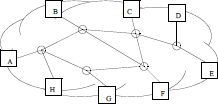Chapter 14
MPLS (Multi Protocol Label Switching)

14.1. Routing protocols’ limits
IGP protocols, such as OSPF or IS-IS, are adapted to the ISPs’ needs; they have to convey transit traffic. Nevertheless, they have some limits, which we will now discuss.
— The routing tables (or rather the FIB: forwarding information base) are increasingly large. The packet processed in the routers can be slowed down because for each packet more than 300,000 entries must be consulted in this base. This can cause performance problems in a high-speed network. In fact, the lookup number should be limited, since from the ISP’s point of view the packets are routed to one of the edge routers of the ISP’s network, which is equivalent to 100 possibilities. In Figure 14.1, this corresponds to the router A to one of the seven routers (from B to H).
— Routing at the IP level ignores the physical topology of the network. One way to limit the number processes in the core network equipment is to put routers at the edge of the network and switches in the core. The edge routers chose the virtual circuit to transmit a packet from the destination address of the packet header. The process linked to the routing table is carried out once per packet in the ISP’s network. The scalability problem relating to the high number of signalling messages remains when the logical architecture is different to the physical architecture. ...
Get Local Networks and the Internet: From Protocols to Interconnection now with the O’Reilly learning platform.
O’Reilly members experience books, live events, courses curated by job role, and more from O’Reilly and nearly 200 top publishers.

